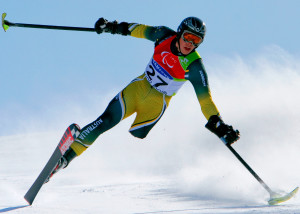About the Sport
Alpine skiing is practiced worldwide and features seven disciplines: downhill, slalom, giant slalom, super-G, super combined, team events and most recently snowboard. Athletes combine speed and agility while racing down slopes at speeds of around 100km/h.
Competition accommodates male and female athletes with a physical impairment such as spinal injury, cerebral palsy, amputation, les autres conditions and blindness/visual impairment.
Athletes compete in three categories based on their functional ability, and a results calculation system allows athletes with different impairments to compete against each other.
Skiers with blindness/visual impairment are guided through the course by sighted guides using signals to indicate the course to follow. Some athletes use equipment that is adapted to their needs including single ski, sit-ski or orthopaedic aids.
IPC Alpine Skiing acts as the International Federation for the sport which is co-ordinated by the IPC Alpine Skiing Technical Committee.
Six events are on the Paralympic Programme: Downhill, Super-G, Super Combined, Giant Slalom, Slalom and Snowboard which will make its debut at the Sochi 2014 Paralympic Winter Games.
Competition description
Downhill
Each athlete competes one run down the course with their finish time determining the final order based on ascending time. Athletes ski down a long, steep course and must pass through a relatively few number of gates. If an athlete misses a gate they are disqualified. For weather, safety and other reasons, the jury can decide to have two-run downhill if the vertical drop does not comply.
Slalom
Each athlete competes two runs on the same day on different courses. Times from the two runs are added together to determine the final order based on ascending total time. It is a technical event over a shorter course than other events but with a high number of gates that the athlete must negotiate. If an athlete misses a gate they are disqualified.
Giant slalom
Each athlete completes two runs on the same day on different courses. Times from the two runs are added together to determine the final order based on ascending total time. It is a technical event with a longer course and fewer gates than the slalom. The number of gates is determined by the vertical drop of the course. If an athlete misses a gate they are disqualified.
Super-G
A speed event where each athlete completes one run down the course with their finish time determining the final order based on ascending time. The course is generally shorter than downhill but longer than slalom and giant slalom.
Super combined
A combined competition which represents the final result of two disciplines – usually one of either a downhill or super-G and a single run of slalom. Each athlete competes two runs on the same day on different courses. Times from the two runs are added together to determine the final order based on ascending total time.
Snowboard cross
Each athlete competes three runs down the course with their finish time of their best two runs determining the final order based on ascending time. There is only one rider on the course at a time. The event takes place on a man-made course constructed from a variety of terrain features like bank turns, various types of jumps and rollers etc.




